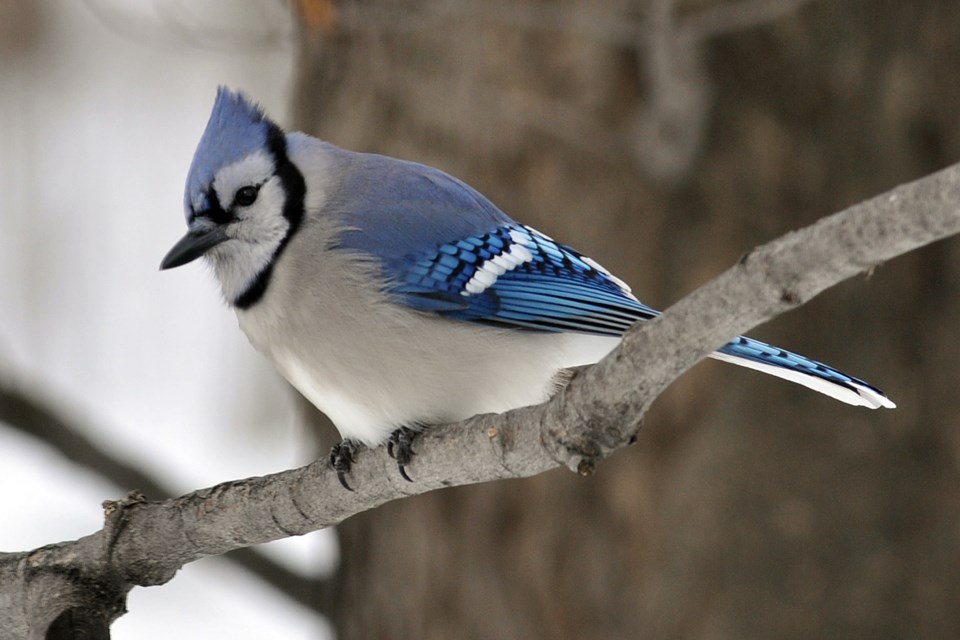Although most of September is still officially summer, a lot of autumnal events start to roll out early in the month.
One such phenomenon is the migration of species from their breeding areas to warmer regions to survive the winter months. Birds do it, some insects do it, even baseball players do it. Which leads me to today's topic, blue jays.
Our local blue jays are perhaps the best and first known of anyone's birdwatching career. Unmistakable in colouration and certainly not quiet about their presence, these members of the crow family live equally at home in both rural and urban settings. Although quieter during the nesting season, almost any walk in the woods will result in an encounter with one of these characters, either visually or audibly.
A quirky fact about those cobalt-blue feathers is that they are actually brown. Due to the minute physical structure of the feather barbs, sunlight is refracted allowing all wavelengths to be absorbed except blue which bounces back. If you hold a blue jay feather up so that it is backlit, the blue disappears. Same thing with bluebird feathers.
During September, a migration of sorts takes place within the blue jay population. Apparently about 20% of the population heads south, with flocks numbering up to 250 birds observed along the north shores of Lake Erie and Lake Ontario.
As many as 900,000 birds a season have been recorded at one station, with the five-year average at about 500,000 birds. Despite the intense studies conducted on blue jays, this partial migration is not yet fully understood.
Two factors do stand out, one being that jays living on the most northerly part of their range (south edge of tundra) tend to migrate moreso than birds living in the central parts of Ontario. While this makes sense from a food availability point-of-view, why migrate through and past habitat that could sustain them? Perhaps resident jays don't take kindly to these immigrants?
The second factor relates to mast production. Mast is the general term to describe the abundance of acorns, beechnuts, hazelnuts and other tree seeds. In years of poor mast the number of jays winging south increases substantially.
Despite this fluctuation in range, most blue jays stay put and raid our winter feeders with much gusto. Being able to mimic some other birds, jays will give a perfect rendition of a red-tailed hawk or a red-shouldered hawk just prior to hitting the sunflower seeds, thus scaring off other feeder birds.
Historically, blue jays are accredited for the dispersal and range increases of oak trees.
A couple thousand years after the recent glacier melted away and soils formed deep enough for tree roots, jays kept hiding acorns along the northern boundary of this available land. Inside a jay's throat is a 'gular pouch' which acts like an inside lunch bag; two to three acorns at a time can be slipped in here, plus one in the mouth and another held with the beak tip. Therefore up to five acorns a trip could be found and transported to a hiding place. It is estimated that each blue jay could plant 4,000 acorns a season!
For years I have been loath to like blue jays as I saw them as egg thieves, creating havoc by eating the eggs and newly hatched young of other songbirds. However, upon reading of some research that was done on the analysis of blue jay stomach contents, only 6 of 530 samples contained bird bits, the rest of the diet being insects, acorns and seeds. So now I guess I have to be like everybody else and like blue jays.
Despite their likeability, blue jays have come in second place on two major competitions, the race to be Ontario's bird emblem and more recently to be Canada's avian representative.
Back in the late 1980s Ontario had the pine tree, the white trillium, and the mineral amethyst officially representing our great province.
A 'contest' was held for school children to pick a bird species to join this list of provincial icons. After much deliberating the blue jay was the lead candidate and as such was presented for legal acceptance.
However after two of three readings at Queen's Park, and just before the third and final reading, the Blue Jays baseball team lost their championship title. Fearing that accepting the blue jay as our representative would send a message that Ontario is a bunch of losers, the final reading was scrubbed. Years later the common loon became our symbol of Ontar-i-ari-o.
And a year or so ago the grey jay (now known as the Canada jay) was chosen as our federal rep. Ah well, go jays go.
